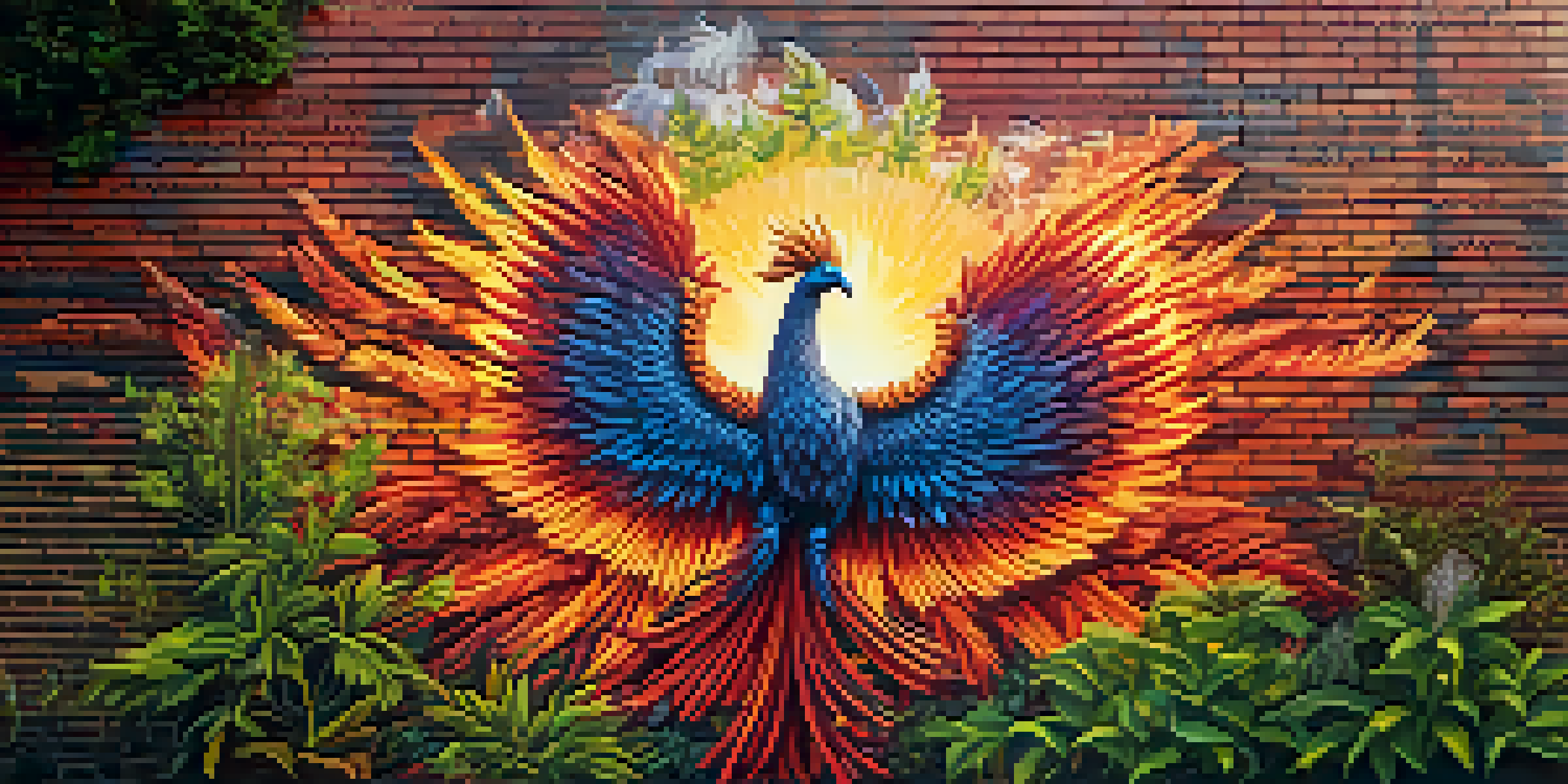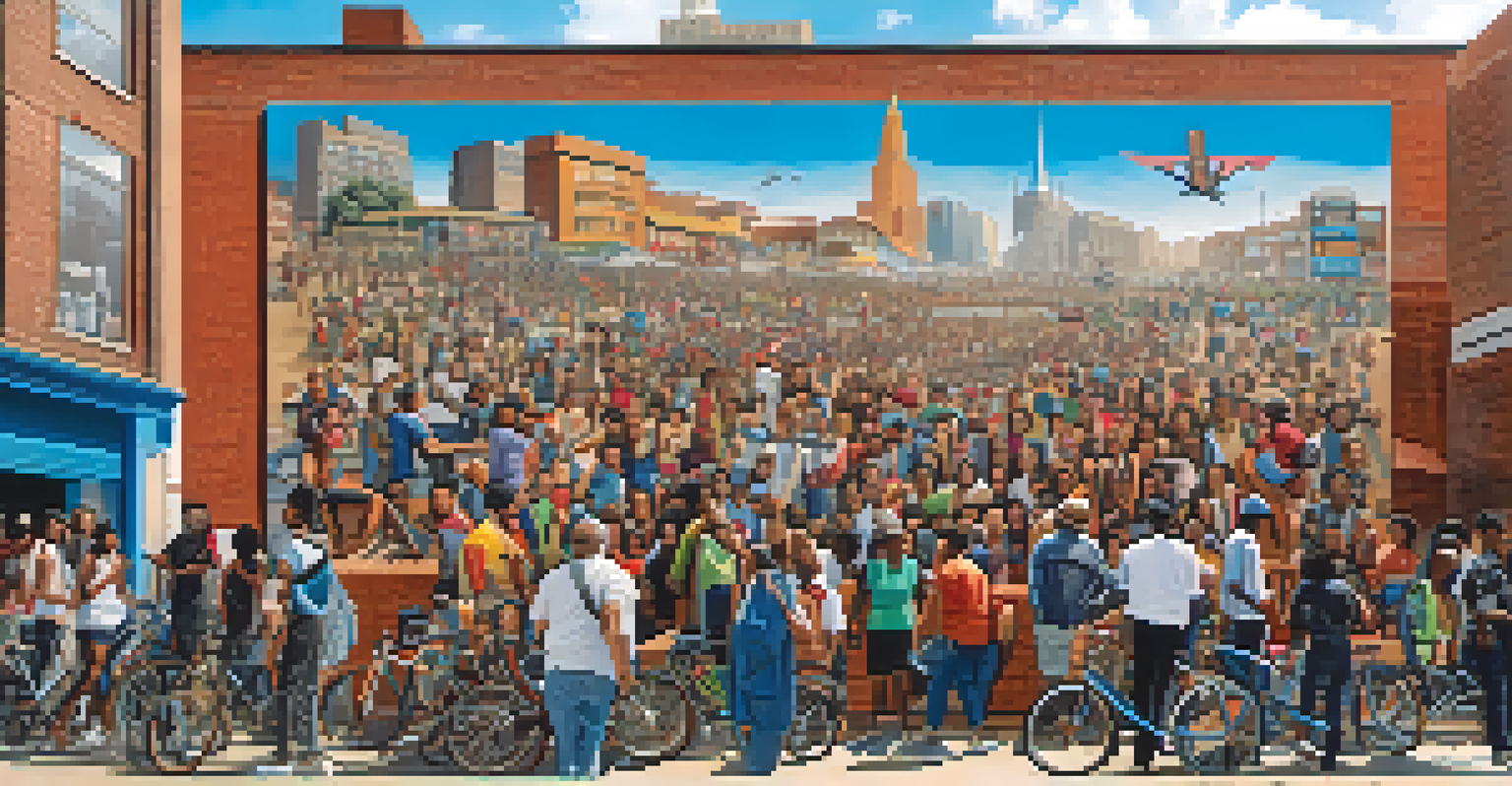The Intersection of Street Art and Street Photography Culture

Understanding Street Art: More Than Just Graffiti
Street art is often misunderstood as mere graffiti, but it's a rich tapestry of creativity thriving in urban environments. Artists use public spaces as their canvas to express thoughts, emotions, and social commentary, transforming mundane walls into vibrant narratives. From intricate murals to thought-provoking installations, street art invites onlookers to engage with their surroundings in new ways.
Art is not what you see, but what you make others see.
The appeal of street art lies in its accessibility; anyone walking by can appreciate the artistry without needing a ticket or a gallery pass. This democratization of art encourages community involvement, sparking conversations among locals about the themes and messages conveyed. As viewers, we become part of the dialogue that street artists initiate, allowing us to reflect on our environment and society.
Moreover, street art often aims to challenge the status quo, addressing issues like inequality, politics, and cultural identity. This rebellious spirit draws parallels to the world of street photography, where photographers capture candid moments that reveal deeper truths about life in the city. Together, they create a visual dialogue that enriches urban culture and fosters connections among diverse communities.
The Role of Street Photography in Documenting Urban Art
Street photography serves as a powerful tool for documenting the ephemeral nature of street art. With the ever-changing landscape of urban environments, many street artworks are temporary, fading away or being replaced over time. Photographers capture these moments, preserving the legacy of artists and their messages before they disappear from view.

By photographing street art, photographers contribute to a broader conversation about the value of public art and its impact on communities. These images can inspire others to seek out and engage with street art in their own neighborhoods, fostering a sense of appreciation for local talent. The shared images also create a collective memory of the art movement, allowing future generations to understand its significance.
Street Art: A Voice for Change
Street art serves as a powerful medium for artists to address societal issues and provoke meaningful conversations in public spaces.
Additionally, street photography often adds context to the artwork, showcasing the environment in which it exists. Capturing interactions between people and art can create compelling narratives that highlight the relationship between the artwork and its audience. This interplay can lead to a deeper understanding of both street art and the stories that unfold within urban spaces.
Cultural Significance: Street Art and Its Social Commentary
Street art often serves as a reflection of society, tackling pressing issues such as racism, poverty, and political unrest. Artists use their work to provoke thought and spark conversations about these critical topics, making art a catalyst for social change. By addressing these issues in public spaces, they invite everyone to engage with the content, regardless of their background.
Creativity takes courage.
Street photographers, in turn, capture these moments of social commentary, showcasing the impact of street art on communities. Images of powerful murals can amplify the messages behind them, reaching wider audiences through social media and other platforms. This visual storytelling fosters empathy and understanding, encouraging viewers to reflect on their own experiences and perspectives.
Furthermore, the collaboration between street artists and photographers can lead to unique projects that bridge art and advocacy. Events such as street art festivals often feature both mediums, creating opportunities for dialogue and collaboration. By combining their talents, artists and photographers can work together to amplify their voices and create lasting change in their communities.
The Evolution of Street Art and Photography in the Digital Age
The rise of social media has transformed the way street art and photography are shared and appreciated. Platforms like Instagram allow artists and photographers to reach global audiences instantly, showcasing their work to millions. This digital exposure has given birth to new styles and trends, as artists adapt their work to fit the online landscape.
Moreover, digital technology has made it easier for photographers to document and edit their images, enhancing their storytelling capabilities. High-quality cameras and editing software allow for a more polished presentation of street art, capturing the nuances of color and texture that may be lost in traditional photography. This evolution has elevated the appreciation of street art as a legitimate form of artistic expression.
Photography Preserves Urban Art
Street photography captures the ephemeral nature of street art, preserving its legacy and fostering appreciation within communities.
However, the digital age also poses challenges, such as the risk of commodification and the dilution of the original message. As street art becomes more mainstream, some argue that its rebellious spirit may fade. Yet, the ongoing dialogue between street artists and photographers can help maintain the authenticity of this cultural movement, ensuring that both mediums continue to thrive in a rapidly changing world.
Collaborations: The Synergy Between Artists and Photographers
Collaborations between street artists and photographers can create powerful, multi-dimensional projects that highlight the strengths of both mediums. These partnerships often result in unique exhibitions or publications that showcase the interplay between street art and photography, inviting audiences to experience the art in fresh ways. By combining their creative visions, artists and photographers can push boundaries and explore new narratives.
One notable example is the trend of 'street art tours,' where photographers document artists at work, capturing the process behind the creation of murals. These behind-the-scenes glimpses not only celebrate the artistry but also humanize the creators, allowing viewers to connect with the people behind the art. Such collaborations can foster community engagement and support for local artists.
Additionally, these partnerships can lead to innovative uses of technology, such as augmented reality experiences that blend street art with digital photography. This fusion can create immersive experiences that captivate audiences and encourage them to explore their surroundings in new ways. As street art and photography continue to evolve, the possibilities for collaboration are limitless.
The Impact of Street Art and Photography on Urban Communities
Street art and photography have the potential to reshape urban communities by fostering a sense of identity and pride. Murals and installations can serve as landmarks that bring people together, sparking conversations and encouraging community involvement. This revitalization of public spaces can lead to increased foot traffic, benefiting local businesses and creating a vibrant atmosphere.
Moreover, both street art and photography can help to humanize urban spaces, challenging negative stereotypes often associated with city living. By showcasing the beauty and creativity within communities, these mediums can inspire residents to take ownership of their environment and advocate for positive change. This shift in perspective can lead to a more inclusive and supportive community fabric.
Collaboration Enhances Creativity
Partnerships between street artists and photographers lead to innovative projects that explore new narratives and engage audiences.
Additionally, initiatives that encourage community participation in street art and photography projects can strengthen bonds among residents. Workshops, mural projects, and exhibitions create opportunities for collaboration and self-expression, empowering individuals to share their stories. As communities engage in these creative endeavors, they cultivate a sense of belonging and pride that can resonate for generations.
Conclusion: Embracing the Future of Street Culture
The intersection of street art and street photography is a dynamic space that continues to evolve, reflecting the pulse of urban life. As both mediums adapt to new technologies and cultural shifts, they remain vital forms of expression that inspire conversation and connection. By celebrating the unique relationship between street artists and photographers, we can foster a deeper appreciation for the creativity that thrives in our cities.
Looking ahead, it's essential to support emerging artists and photographers who are pushing the boundaries of their craft. Encouraging collaboration and dialogue among these creatives can lead to innovative projects that resonate with diverse audiences. As we embrace the future of street culture, we must also recognize the importance of preserving the authenticity and spirit that define these art forms.

Ultimately, the fusion of street art and photography is a testament to the power of creativity in shaping our urban landscapes. By engaging with these mediums, we can cultivate a richer understanding of our communities and the stories they tell. So, grab your camera or explore your local streets, and immerse yourself in the vibrant world of street art and photography.